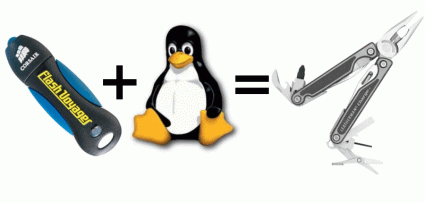Knoppix Linux On USB
Knoppix: The "Leatherman" For PCs
There's no mistaking the practical purpose behind a bootable live-demonstration Linux distribution for on-the-go technicians. As avid consumers of modern technology, many of us enjoy exercising our electronic toys as much as our minds. However, we sometimes lack the software tools necessary to troubleshoot, diagnose, and resolve problems as they arise. This article provides a gentle introduction to how a simple Knoppix configuration can become an indispensable item in a mobile technical toolkit.
Finding a practical solution is literally within arm's reach - you need look no further than your USB flash drive. Normally viewed as an inert storage medium, a USB flash drive can be easily modified into a multi-purpose tool that is quite effective when appointed with the trappings of a modern operating system and ancillary applications. Just imagine the possibilities that a full-fledged OS can deliver, once it has been streamlined to work within the tightest of resource constraints - an ordinary (and not terribly large) USB flash drive.
Technical Discussion
Bootable Live-CD distributions make up a growing contingent of the available helpful utilities and purpose-built applications or frameworks, which bootstrap right into live demonstrations of what given platforms or products do best. The concept of using a ready-made utility disc to service a variety of occupations, from in-house technical service departments to traveling salespeople, is well known and wisely used, but this concept is not unique to optical drive media. In fact, most of this capability migrates very nicely to USB flash media, thereby enabling a whole new level of portable capabilities.
To be sure, optical drives are well understood and universal at this point, but so is USB. And, USB interfaces also typically outnumber CD-ROM and DVD-ROM drives - a typical workstation might have one or two optical drives, but will typically offer anywhere from four to 10 USB ports; even notebooks feature between two and six ports. Besides, who wants to carry around an optical disc when more practical and portable options are so readily available?
The number of potential candidates is overwhelming: Knoppix.net alone serves 95 unique entries for a range of purposes, from system repair images to industry-compliant forensics suites, in addition to the typical demonstration desktop or server operating systems. This encompasses only those entries associated specifically with Knoppix, and does not account for the many pet projects that spawn from other derived platforms or competitor distributions such as Pebble, DSL (Darn Small Linux, in its most polite expansion), Bent, CX, and so forth.
This article assumes a basic working knowledge of the Linux platform, USB drive technology, and the concept of loopback devices. Indeed, it makes sense to assume prior experience with Linux for those who want to create a suitable system repair disk designed for this operating system, though there are methods for creating and using Linux-based applications for Windows-specific tasks as well (such as scanning for malware, or looking for signs of intrusion and system compromise).
Join our discussion on this topic
Get Tom's Hardware's best news and in-depth reviews, straight to your inbox.
Ed Tittel is a long-time IT writer, researcher and consultant, and occasional contributor to Tom’s Hardware. A Windows Insider MVP since 2018, he likes to cover OS-related driver, troubleshooting, and security topics.

